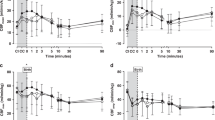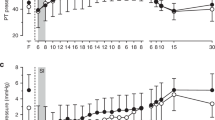Abstract
Positive end expiratory pressure (PEEP) is important for neonatal ventilation but is not considered in guidelines for resuscitation. Our aim was to investigate the effects of PEEP on cardiorespiratory parameters during resuscitation of very premature lambs delivered by hysterotomy at ∼125 d gestation (term ∼147 d). Before delivery, they were intubated and lung fluid was drained. Immediately after delivery, they were ventilated with a Dräger Babylog plus ventilator in volume guarantee mode with a tidal volume of 5 mL/kg. Lambs were randomized to receive 0, 4, 8, or 12 cm H2O of PEEP. They were ventilated for a 15-min resuscitation period followed by 2 h of stabilization at the same PEEP. Tidal volume, peak inspiratory pressure, PEEP, arterial pressure, oxygen saturation, and blood gases were measured regularly, and respiratory system compliance and alveolar/ arterial oxygen differences were calculated. Lambs that received 12 cm H2O of PEEP died from pneumothoraces; all others survived without pneumothoraces. Oxygenation was significantly improved by 8 and 12 cm H2O of PEEP compared with 0 and 4 cm H2O of PEEP. Lambs with 0 PEEP did not oxygenate adequately. The compliance of the respiratory system was significantly higher at 4 and 8 cm H2O of PEEP than at 0 PEEP. There were no significant differences in partial pressure of carbon dioxide in arterial blood between groups. Arterial pressure was highest with 8 cm H2O of PEEP, and there was no cardiorespiratory compromise at any level of PEEP. Applying PEEP during resuscitation of very premature infants might be advantageous and merits further investigation.
Similar content being viewed by others
Log in or create a free account to read this content
Gain free access to this article, as well as selected content from this journal and more on nature.com
or
Abbreviations
- AaDO2:
-
alveolar-arterial oxygen difference
- CPAP:
-
continuous positive airway pressure
- CRS:
-
compliance of the respiratory system
- Fio2:
-
fraction of inspired oxygen
- FRC:
-
functional residual capacity
- MAP:
-
mean arterial pressure
- Paco2:
-
partial pressure of carbon dioxide in arterial blood
- Pao2:
-
partial pressure of oxygen in arterial blood
- PEEP:
-
positive end expiratory pressure
- PIP:
-
peak inspiratory pressure
- RDS:
-
respiratory distress syndrome
- Sao2:
-
oxygen saturation
- VT:
-
tidal volume
References
Kattwinkel J, Niermeyer S, Nadkarni V, Tibballs J, Phillips B, Zideman D, Van Reempts P, Osmond M 1999 ILCOR advisory statement: resuscitation of the newly born infant. An advisory statement from the pediatric working group of the International Liaison Committee on Resuscitation. Circulation 99: 1927–1938.
Phillips B, Zideman D, Wyllie J, Richmond S, Van Reempts P 2001 European Resuscitation Council Guidelines 2000 for Newly Born Life Support. A statement from the Paediatric Life Support Working Group and approved by the Executive Committee of the European Resuscitation Council. Resuscitation 48: 235–239.
Clark RH 1999 Support of gas exchange in the delivery room and beyond: how do we avoid hurting the baby we seek to save? Clin Perinatol 26: 669–681, vii–viii
Finer NN, Rich W, Craft A, Henderson C 2001 Comparison of methods of bag and mask ventilation for neonatal resuscitation. Resuscitation 49: 299–305.
Gregory GA, Kitterman JA, Phibbs RH, Tooley WH, Hamilton WK 1971 Treatment of the idiopathic respiratory distress syndrome with continuous positive airway pressure. N Engl J Med 284: 1333–1340.
Michna J, Jobe AH, Ikegami M 1999 Positive end-expiratory pressure preserves surfactant function in preterm lambs. Am J Respir Crit Care Med 160: 634–639.
Naik S, Greenough A, Giffin FJ, Baker A 1998 Manoeuvres to elevate mean airway pressure, effects on blood gases and lung function in children with and without pulmonary pathology. Eur J Pediatr 157: 309–312.
Shaffer TH, Koen PA, Moskowitz GD, Ferguson JD, Delivoria-Papadopoulos M 1978 Positive end expiratory pressure: effects on lung mechanics of premature lambs. Biol Neonate 34: 1–10.
Dinger J, Topfer A, Schaller P, Schwarze R 2001 Effect of positive end expiratory pressure on functional residual capacity and compliance in surfactant-treated preterm infants. J Perinat Med 29: 137–143.
Thome U, Topfer A, Schaller P, Pohlandt F 1998 The effect of positive endexpiratory pressure, peak inspiratory pressure, and inspiratory time on functional residual capacity in mechanically ventilated preterm infants. Eur J Pediatr 157: 831–837.
Vilstrup CT, Bjorklund LJ, Larsson A, Lachmann B, Werner O 1992 Functional residual capacity and ventilation homogeneity in mechanically ventilated small neonates. J Appl Physiol 73: 276–283.
Nilsson R, Grossmann G, Robertson B 1980 Artificial ventilation of premature newborn rabbits: effects of positive end expiratory pressure on lung mechanics and lung morphology. Acta Paediatr Scand 69: 597–602.
Argiras EP, Blakeley CR, Dunnill MS, Otremski S, Sykes MK 1987 High PEEP decreases hyaline membrane formation in surfactant deficient lungs. Br J Anaesth 59: 1278–1285.
Sandhar BK, Niblett DJ, Argiras EP, Dunnill MS, Sykes MK 1988 Effects of positive end-expiratory pressure on hyaline membrane formation in a rabbit model of the neonatal respiratory distress syndrome. Intensive Care Med 14: 538–546.
Naik AS, Kallapur SG, Bachurski CJ, Jobe AH, Michna J, Kramer BW, Ikegami M 2001 Effects of ventilation with different positive end-expiratory pressures on cytokine expression in the preterm lamb lung. Am J Respir Crit Care Med 164: 494–498.
Harrison VC, Heese HB, Klein M 1968 The significance of grunting in hyaline membrane disease. Pediatrics 41: 549
Milner AD 1991 Resuscitation of the newborn. Arch Dis Child 66: 66–69.
Harding R, Hooper SB 1996 Regulation of lung expansion and lung growth before birth. J Appl Physiol 81: 209–224.
Baraldi E, Pettenazzo A, Filippone M, Magagnin P, Saia OS, Zacchello F 1993 Rapid improvement of static compliance after surfactant treatment in preterm infants with respiratory distress syndrome. Pediatr Pulmonol 15: 157–162.
Attar MA, Donn SM 2002 Mechanisms of ventilator-induced lung injury in premature infants. Semin Neonatol 7: 353–360.
Bjorklund LJ, Ingimarsson J, Curstedt T, John J, Robertson B, Werner O, Vilstrup CT 1997 Manual ventilation with a few large breaths at birth compromises the therapeutic effect of subsequent surfactant replacement in immature lambs. Pediatr Res 42: 348–355.
Jobe AH, Kramer BW, Moss TJ, Newnham JP, Ikegami M 2002 Decreased indicators of lung injury with continuous positive expiratory pressure in preterm lambs. Pediatr Res 52: 387–392.
Harding R, Johnson P, McClelland ME 1980 Respiratory function of the larynx in developing sheep and the influence of sleep state. Respir Physiol 40: 165–179.
Stark AR, Cohlan A, Waggener TB, Frantz ID, Kosch PC 1987 Regulation of end-expiratory lung volume during sleep in premature infants. J Appl Physiol 62: 1117–1123.
Carlo WA, Kosch PC, Bruce EN, Strohl KP, Martin RJ 1987 Control of laryngeal muscle activity in preterm infants. Pediatr Res 22: 87–91.
Miller J, Law AB, Parker RA, Sundell H, Silberberg AR, Cotton RB 1994 Effects of morphine and pancuronium on lung volume and oxygenation in premature infants with hyaline membrane disease. J Pediatr 125: 97–103.
Wiswell TE, Gannon CM, Jacob J, Goldsmith L, Szyld E, Weiss K, Schutzman D, Cleary GM, Filipov P, Kurlat I, Caballero CL, Abassi S, Sprague D, Oltorf C, Padula M 2000 Delivery room management of the apparently vigorous meconium-stained neonate: results of the multicenter, International Collaborative Trial. Pediatrics 105: 1–7.
Ho JJ, Subramaniam P, Henderson-Smart DJ, Davis PG 2002 Continuous distending pressure for respiratory distress syndrome in preterm infants. Cochrane Database Syst Rev 2: CD002271
Morley CJ 1999 Continuous distending pressure. Arch Dis Child Fetal Neonatal Ed 81: F152–F156.
Pringle KC 1986 Human fetal lung development and related animal models. Clin Obstet Gynecol 29: 502–513.
Greenspan JS, Abbasi S, Bhutani VK 1988 Sequential changes in pulmonary mechanics in the very low birth weight (less than or equal to 1000 grams) infant. J Pediatr 113: 732–737.
Itakura Y, Ogawa Y 1998 Effect of body position on tidal volume and minute ventilation in very low birthweight infants. Acta Paediatr Jpn 40: 555–557.
Kacmarek RM 1999 Ventilator-associated lung injury. Int Anesthesiol Clin 37: 47–64.
Dreyfuss D, Basset G, Soler P, Saumon G 1985 Intermittent positive-pressure hyperventilation with high inflation pressures produces pulmonary microvascular injury in rats. Am Rev Respir Dis 132: 880–884.
International Consensus Conferences in Intensive Care Medicine 1999 Ventilator-associated lung injury in ARDS. Am J Respir Crit Care Med 160: 2118–2124.
Varughese M, Patole S, Shama A, Whitehall J 2002 Permissive hypercapnia in neonates: the case of the good, the bad, and the ugly. Pediatr Pulmonol 33: 56–64.
Shortland DB, Field D, Archer LNJ, Gibson NA, Woods KL, Evans DH, Levene MI 1989 Cerebral haemodynamic effects of changes in positive end expiratory pressure in preterm infants. Arch Dis Child 64: 465–469.
Hausdorf G, Hellwege H-H 1987 Influence of positive end-expiratory pressure on cardiac performance in premature infants: a doppler-echocardiographic study. Crit Care Med 15: 661–664.
Aufricht C, Frenzel K, Votava F, Simbruner G 1995 Quasistatic volume-pressure curve to predict the effects of positive end-expiratory pressure on lung mechanics and gas exchange in neonates ventilated for respiratory distress syndrome. Am J Perinatol 12: 67–72.
Greenough A, Morley CJ, Davis JA 1983 Respiratory reflexes in ventilated premature babies. Early Hum Dev 8: 65–75.
Saugstad OD 2001 Resuscitation of newborn infants with room air or oxygen. Semin Neonatol 6: 233–239.
Author information
Authors and Affiliations
Corresponding author
Additional information
This study was supported by the National Health and Medical Research Council, Australia, grant number 148003.
Rights and permissions
About this article
Cite this article
Probyn, M., Hooper, S., Dargaville, P. et al. Positive End Expiratory Pressure during Resuscitation of Premature Lambs Rapidly Improves Blood Gases without Adversely Affecting Arterial Pressure. Pediatr Res 56, 198–204 (2004). https://doi.org/10.1203/01.PDR.0000132752.94155.13
Received:
Accepted:
Issue date:
DOI: https://doi.org/10.1203/01.PDR.0000132752.94155.13
This article is cited by
-
Respiratory strategy at birth initiates distinct lung injury phenotypes in the preterm lamb lung
Respiratory Research (2022)
-
Higher CPAP levels improve functional residual capacity at birth in preterm rabbits
Pediatric Research (2022)
-
Stimulating and maintaining spontaneous breathing during transition of preterm infants
Pediatric Research (2021)
-
Versorgung und Reanimation des Neugeborenen nach der Geburt
Notfall + Rettungsmedizin (2021)
-
Application of two different nasal CPAP levels for the treatment of respiratory distress syndrome in preterm infants—“The OPTTIMMAL-Trial”—Optimizing PEEP To The IMMAture Lungs: study protocol of a randomized controlled trial
Trials (2020)



